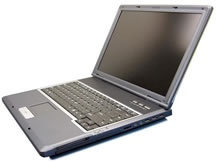Ultra-Portable Laptops
Hold any interest raiding the Horde on your morning jog? Okay, so whatever it is that you intend on doing with an ultra-portable, we've got you covered with some specification blueprints you should keep your eyes on.
We have differentiated two ultra-portable systems: Standard and Performance.
The first describes a well-equipped laptop in the 11-inch to 12-inch LCD range, usually very lightweight and characteristic of the Sony Vaio TZ range and its competitors. These systems use low power dual core processors, usually integrated video and smallish slower hard drives (so picking a 5400rpm HDD in this category can be considered a big plus).
Our performance ultra-portable spec, in the other hand, corresponds to the category that the Apple Macbook Air debuted not so long ago. Not too many competitors have risen so far in this range, though the ThinkPad X300 is a perfect example of a very lightweight yet powerful system.
You can get upgraded processing power all-around compared to the standard ultra-portable spec at the cost of size since these models usually sport a sleek yet slightly larger 13-inch screen. Whenever possible we recommend you upgrade to non-integrated graphics though it will be tough to find a system that has it all in such a compact chassis.
Component
|
Ultra Portable Standard
|
Ultra Portable Performance
|
| Processor: | Intel Core 2 Duo Mobile U7500 1.2GHz / Core 2 Duo L7400 1.5GHz | Intel Core 2 Duo L7500 1.6GHz / Core 2 Duo P8600 2.4GHz |
| RAM: | 2GB DDR2 533MHz | 4GB DDR2 667MHz |
| Video: | Intel GMA X3100 / ATI X1250 | Intel integrated, Nvidia GeForce 8400M GT |
| Audio: | Integrated audio | |
| HDD: | 100GB+ HDD (5400RPM whenever availabe) | 160GB+ 5400RPM or 64GB Solid State Drive |
| Optical: | None / Internal DVD+/-RW | |
| Network: | Integrated 10/100/1000 Ethernet | |
| Wireless: | Internal 802.11 g/n and Bluetooth WAN connectivity as needed (check with your ISP) |
|
| Display: | 11"-13" LCD | 12"-13" LED backlit panel |
| Battery: | 4 - 6 Cell Lithium Ion | 4 - 9 Cell Lithium Ion |
Interfaces you may require: |
Express Card slot, 2+ USB 2.0 ports, IEEE 1394 port(s), DVI/HDMI/VGA/S-Video port(s), Cable lock slot | Express Card slot, 2+ USB 2.0 ports, IEEE 1394 port(s), DVI/HDMI/VGA/S-Video port(s), Cable lock slot, Docking station support |
It is also relevant to add that most ultra-portable systems offer the option of wireless WAN connectivity, so you may want to check what are the ISP offerings in your area.
If your ultra-portable will not have substantial load placed on it and you'd prefer the additional portability, it's worth taking a glance at systems such as the Asus Eee PC. This new category of ultra-portables happen to be even cheaper than run of the mill budget laptops, though because of size and performance constraints, these are usually reserved for use as a secondary or even tertiary systems. Many of the leading laptop manufacturers currently offer (or eventually will offer) ultra-portables that compare to the Eee, so shop around a bit.
